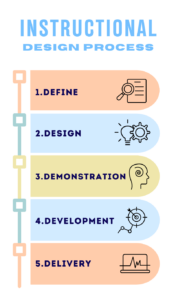Iterative Instructional Design
A Dynamic Process of Feedback and Evaluation
By: Dr. Brie Nelson
Instructional design is a dynamic process that involves incremental development and refining techniques through feedback and evaluation. Iterative instructional design involves multiple rounds of review before settling on a final product. The instructional design process involves five phases: Define, Design, Demonstrate, Develop, and Deliver. Each phase incorporates elements of systematically designed instruction, such as learners’ needs and characteristics, desired learning outcomes, assessments, instructional activities, and evaluation.
 The Define phase determines the project scope, products, schedule, and deliverables. The project manager, designer, and client collaborate to clarify the type of constituent who will be utilizing the requested design, what needs to be accomplished, the requested length, feel, and kind of design, and identify any limiting factors.
The Define phase determines the project scope, products, schedule, and deliverables. The project manager, designer, and client collaborate to clarify the type of constituent who will be utilizing the requested design, what needs to be accomplished, the requested length, feel, and kind of design, and identify any limiting factors.
This phase explores the typical background of students, including personal and educational information such as age, nationality, and previous experiences. It should also consider the target group, educational goals, past knowledge levels, experiences, ages, interests, and cultural background. The program should address the learner’s needs, skills, intelligence, outlook, and desired learning outcomes. Popular methods and instructional strategies should be reviewed to ensure their adequacy. The project’s target objectives should be determined, and various learning environments should be considered. The preferred learning environment may be online, face-to-face, or both. Limiting factors to the project’s overall goal include technical support, time, human resources, technical skills, financial, and support elements. By identifying these factors, the design can effectively address the learners’ needs and achieve desired learning outcomes.
The Design phase involves defining learner needs, identifying subskills, creating an assessment plan, identifying instructional strategies, brainstorming activities, determining content scope, acquiring content, and planning prototype testing and formative evaluation. The approach at this stage should be logical and systematic. Each design element should be executed with attention to detail and intentionality.
The design may have various media types, such as audio, video, and graphics. Consider whether the design will require third-party resources or if the instructional designers will create their own. What voice or approach should be used? The time frame for each activity will be determined, and the topics will be presented in a linear progression. The mental processes participants need will be assessed, and prescribed cognitive skills will be developed. Knowledge and skills acquired after each task will be determined, and the method adopted to evaluate the acquisition of desired competencies will be discussed. A roadmap for the study or project will be created, and a web-based user interface will be employed. A feedback mechanism will determine if participants can digest the lessons. The design should appeal to diverse learning styles and interests, with various delivery options and media types. The purpose of the design will be outlined, and the project will be evaluated based on the identified criteria.
The Demonstration phase develops design specifications and ensures quality through prototyping. It monitors materials for learners’ needs, aligns activities with learning outcomes, includes assessments, and aligns materials with the instructional strategy. Development involves creating and testing learning outcomes to ensure time frame adherence, material creation according to schedule, effective teamwork, optimal participant contributions, and materials being up to the task for their intended purpose. It also assesses collaboration, optimal capacity, and material quality.
The Development phase involves collaborating with team members to ensure materials are suitable for audience characteristics, activities align with learning outcomes, assessments are included, and learning materials align with the instructional strategy.
Determine the preferred method of record keeping and data collection from student interaction with a project. Assess the emotional feedback received by teachers and students during the initial demonstration, their comprehension of the topic, and their response to potential errors during testing. Determine between small or large-scale implementation and whether students can work independently or require constant guidance. The feedback provides valuable insights into the design’s success and potential challenges.
The Delivery phase involves delivering materials to the client, providing recommendations for future development, and providing client training. This phase also includes conducting a post-project review to assess team effectiveness, ensuring appropriate materials, aligned learning objectives, and implementing planned materials properly.
Evaluation of the design is a crucial step for any instructional design process, aiming to assess the project’s effectiveness by establishing categories, determining factors or criteria for effectiveness, implementing data collection, analyzing participant feedback, determining if parts need to be changed before full release, observing reliability and content validity, assessing clear instructions, and analyzing and grading participant responses. It also determines who receives the final output and who will prepare the evaluation report. The evaluation process helps determine the reliability, content validity, and clarity of instructions, ultimately ensuring the project’s success. The iterative instructional design process enables faster decision-making and a deeper understanding of each element, leading to informed decisions and successful project conclusions.
To learn how eLearningDOC can help you with your next project, contact the DOC today!








